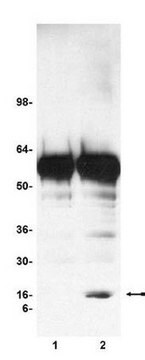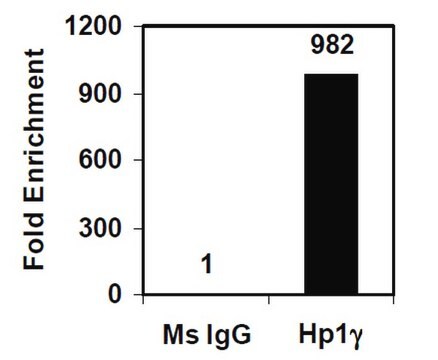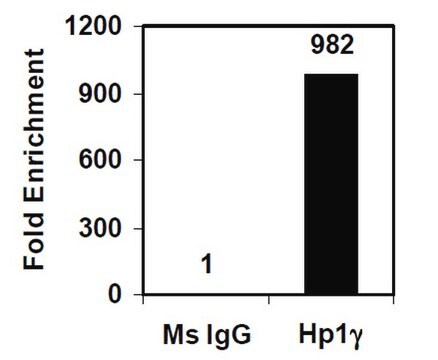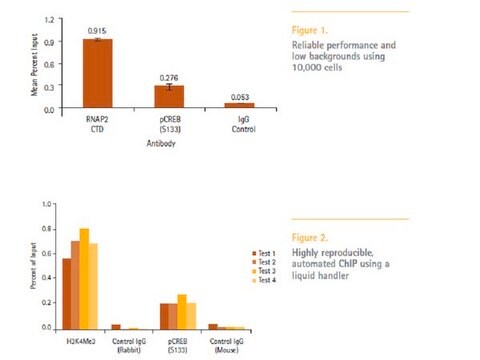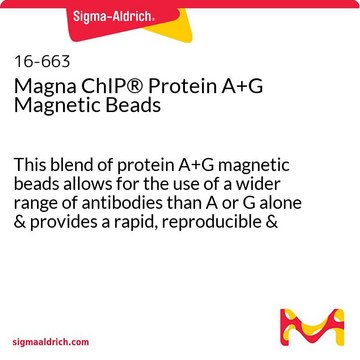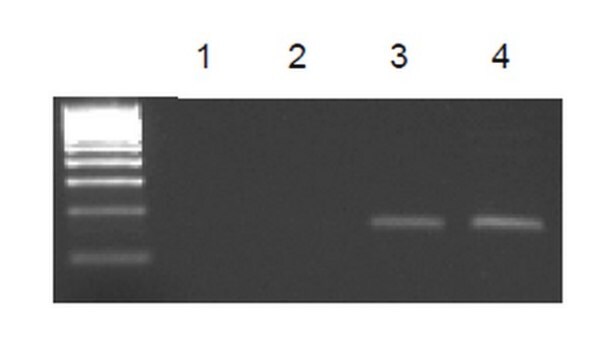CHP1
Imprint® Chromatin Immunoprecipitation Kit
Complete ChIP reaction in 6 hours in flexible strip well format
Synonim(y):
Immunoprecypitacja chromatyny
About This Item
Polecane produkty
temp. przechowywania
−20°C
Powiązane kategorie
Opis ogólny
For Frequently Asked Questions about this kit, please see ChIP Troubleshooting Questions.
Zastosowanie
- Suitable for downstream applications
- Individual target characterization to genome-wide profiling techniques
- Characterization of signal transduction pathways
- Verification of ChIp-chIP and ChIP-seq data
Cechy i korzyści
- Fast—Total protocol time of less than 6 hours making the Imprint kit the fastest on the market
- Sensitive—As few as 10,000 cells required for each ChIP sample
- Convenient—Fewest steps of any available ChIP protocol
- Flexible—Protocols for cells or tissue, and convenient strip-well format for high-throughput applications
- Complete—Includes columns and reagents for DNA purification as well as an integrated protocol for amplification with the GenomePlex technology
Informacje prawne
Elementy zestawu są też dostępne oddzielnie
- C2112Column Preparation SolutionKarta charakterystyki
- P4850Proteinase K from Tritirachium album, buffered aqueous glycerol solution, for molecular biology, ≥800 units/mLKarta charakterystyki
- P8340Protease Inhibitor Cocktail, for use with mammalian cell and tissue extracts, DMSO solutionKarta charakterystyki
produkt powiązany
Hasło ostrzegawcze
Danger
Zwroty wskazujące rodzaj zagrożenia
Zwroty wskazujące środki ostrożności
Klasyfikacja zagrożeń
Acute Tox. 4 Oral - Aquatic Chronic 3 - Eye Irrit. 2 - Flam. Liq. 2 - Met. Corr. 1 - Resp. Sens. 1 - Skin Irrit. 2 - STOT SE 3
Organy docelowe
Central nervous system
Kod klasy składowania
3 - Flammable liquids
Temperatura zapłonu (°F)
53.6 °F - closed cup
Temperatura zapłonu (°C)
12 °C - closed cup
Wybierz jedną z najnowszych wersji:
Certyfikaty analizy (CoA)
It looks like we've run into a problem, but you can still download Certificates of Analysis from our Dokumenty section.
Proszę o kontakt, jeśli potrzebna jest pomoc Obsługa Klienta
Masz już ten produkt?
Dokumenty związane z niedawno zakupionymi produktami zostały zamieszczone w Bibliotece dokumentów.
Klienci oglądali również te produkty
Produkty
Epigenetic modifications are thought to occur through two key interconnected processes—DNA methylation and the covalent modification of histones.
Protokoły
Chromatin Immunoprecipitation qPCR for studying gene regulation across conditions.
Immunoprecypitacja chromatyny qPCR do badania regulacji genów w różnych warunkach.
The Sigma Imprint Chromatin Immunoprecipitation Kit uses a plate based system to allow rapid ChIP assays in a high throughput format
Nasz zespół naukowców ma doświadczenie we wszystkich obszarach badań, w tym w naukach przyrodniczych, materiałoznawstwie, syntezie chemicznej, chromatografii, analityce i wielu innych dziedzinach.
Skontaktuj się z zespołem ds. pomocy technicznej